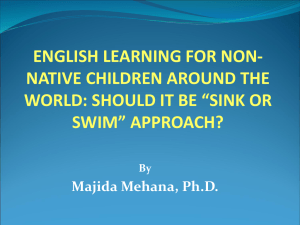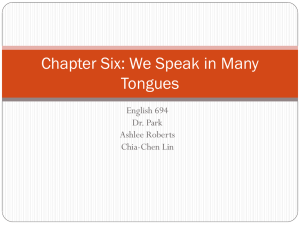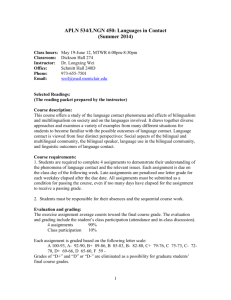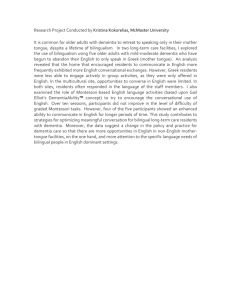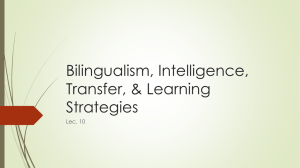View/Open - Indiana State University
advertisement
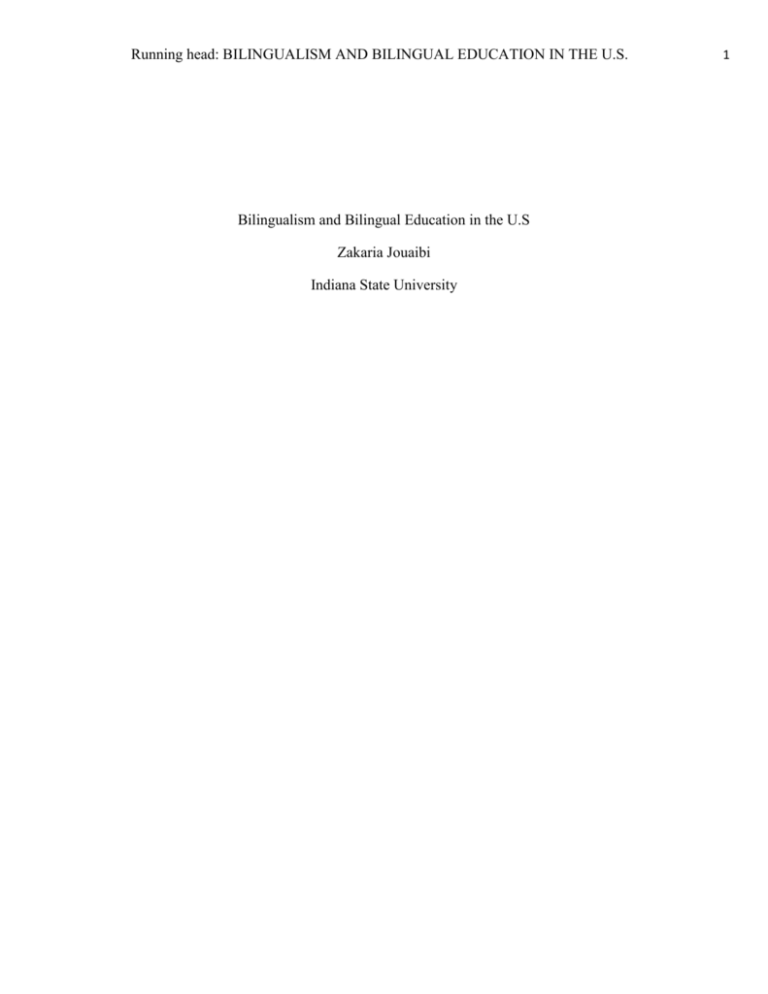
Running head: BILINGUALISM AND BILINGUAL EDUCATION IN THE U.S. Bilingualism and Bilingual Education in the U.S Zakaria Jouaibi Indiana State University 1 BILINGUALISM AND BILINGUAL EDUCATION IN THE U.S. Bilingualism and bilingual education in the U.S. There is no doubt that most developed countries have noticed the drastic influx of immigrants to their territories. This influx has a significant impact on the social and societal texture of those countries; the majority of them have become more aware of bilingualism phenomenon. United States of America is one among the countries that has showed a great interest in bilingualism. The latter plays a vital role to improve the country, create ties, and communicate not only with other nations, but also among its sub-communities since America is a fertile multifarious atmosphere. As a sign of its awareness, United States of America has been trying to implement many reforms and policies to reinforce bilingual education in its schools. Bilingualism and Biculturalism Bilingualism and its Types Before talking about bilingualism and bilingual education in the U.S, the concept of bilingualism should be tackled because of the various definitions that are given to this term. Those definitions seem to share one basic element, which is the use of two given languages by a given speaker. Burk (2005) asserts that, generally, bilingualism is “a term used in linguistics field for the speaking of two languages, and its definition is hotly debated in relation to fluency criteria” (p. 9). In other words, the claim of using two codes is not sufficient enough to provide a complete clear definition of bilingualism. The fluency factor in both languages is one of the significant features that a bilingual person should have. 2 BILINGUALISM AND BILINGUAL EDUCATION IN THE U.S. To achieve fluency in both languages, Stern (1983) believes that the child should be exposed during its infancy to both languages to be fully acquired, not learnt, simultaneously. What can be clearly seen from this quote is that there is no first or second language as the majority thinks; the two languages should be absorbed as one. This automatically implies that there should be a high level proficiency in both linguistic codes. However, recently, the factor of proficiency in both languages has not been a major factor in defining bilingualism or considering a given speaker bilingual. Stern (1983) asserts that “… perfect, full, or equal command in two languages (equilingualism, ambilingualism, balanced bilingualism), is extremely rare” (p. 15). Therefore, the definition of bilingualism has been more flexible. That is to say, “we conclude that, as all second language learning by definition implies the previous presence of a first language, it necessarily leads to bilingualism in the broad sense of this term” (Stern, 1983, p. 15). Burk (2005) avers that there are two main types of bilingualism. First, “ polylingual or ‘compound lingual “ refer to individuals who learned two languages simultaneously during their infancy as one language (p. 16). For example, in a family where the father speaks Arabic and the mother speaks English, children, if they are exposed to both languages, will be proficient in both languages; they will be ‘polylingual’. Second, Cromdal (2000) considers individuals that already acquired their native language first and then learned a second are called “polyglot or coordinate bilinguals, whose languages are considered to operate more separately (as cited in Burk, 2005,p. 16). The first type of bilingualism is rare to find. It is a case where the speaker is equally proficient in the four language skills, reading, speaking, listening and writing. Moreover, the 3 BILINGUALISM AND BILINGUAL EDUCATION IN THE U.S. individual has the ability to use both linguistic codes in all the situations and contexts. Second, ‘polylingual’ refers to a bilingual speaker who does not have full mastery of both codes. Most of the time his or her native language is more dominant than the other language, or he or she has deficiencies in both languages. Using different terms, Pialorsi (1977) also defines and describes bilingualism through relying on two main factors: proficiency and function. “Proficiency categories are ‘complete bilingual’ (equilingual) and partial bilingual. Two other current terms are ‘incipient bilingualism’ and ‘passive bilingualism”. With relevance to functionality, there are terms such as “home bilingualism’, ‘school bilingualism’, and ‘street bilingualism” (p. 94). Similarly, Ballesteros (1969) states that bilingualism is “the ability to engage in communication via more than one language” (p. 867). In other words, it does not necessarily mean that the language skills are equally balanced in each language, nor that there is a fully mastery of the languages (one language can be spoken just as well as poorly as the others). Gafaranga (2007) points out that according to MLF, The Matrix Language Frame, bilinguals, who have a total mastery and full proficiency in both languages, have a great ability to produce the so called “classic codeswitching [sic]” (p. 47). MLF defines ‘code switching’ as an “…alternation between two varieties in the same constituent by speakers who have sufficient proficiency in the two varieties to produce monolingual well-formed utterances in either variety” (p. 48). According to the author, the ability of code switching is resulted from a balanced bilingual speaker. Biculturalism and bilingualism 4 BILINGUALISM AND BILINGUAL EDUCATION IN THE U.S. Burks (2005) claims that not only do bilingual speakers have the ability to perfectly communicate in two languages, but the total knowledge and awareness of the cultural components of each language as well. However, being bilingual does not necessarily mean that the person is bicultural. Unlike Burk, Soffietti (1960) makes a clear distinction between being bilingual and bicultural. He believes that there is an important factor that should be added to have a clear and understanding definition of bilingualism; he asserts that being “… bilingual involves factors that extend beyond those of the “habitual use of two languages” (p. 275). That is to say that bilingualism “…refers not only to two distinct patterns of ‘linguistic habits’, but also to distinct patterns of “cultural habits” in all of their anthropological meaning” (p. 275). He distinguishes among four main situations, bicultural-bilingual, biculturalmonolingual, mono-cultural-bilingual and mono-cultural-monolingual. First, bicultural-bilingual person is the true bilingual speaker since he or she has the capability to communicate using two languages and participating in two communities, totally respecting and functionally conforming the cultural norms of each one. Second, mono-cultural-bilingual person is the one who participates only in one culture; however, he or she definitely learns the second language and perfectly uses it. For example, “when one or both of the parents are bilingual and have decided that at least one of them shall always speak to the child in the foreign language, although the remaining aspects of cultural behavior are those of the community at large” (Soffietti, 1960, p. 276). According to Burk (2005), bicultural-monolingual refers to an individual that stops speaking his or her native language, for some reasons, but he or she keeps his/her “native 5 BILINGUALISM AND BILINGUAL EDUCATION IN THE U.S. customs, beliefs or value patterns” (p. 276). Last, monolingual-monocultural person is the one who acquires neither the linguistic nor cultural components of the foreign language. To illustrate that, he points out that” the most common situation in the United states is the monocuturalmonolingual one” (p. 276). To conclude, the cultural participation of the bilingual speaker in both languages is a significant factor that should be taken into consideration while dealing with the definition of bilingualism, because the mastery of the linguistic elements of both languages is not sufficient. Furthermore, a language does not carry all the cultural specificities of the community; that is why there should be a smorgasbord of interaction in the immediate environment to acquire the cultural elements, which are as important as linguistic ones. Bilingual Education in the U.S Historical Stages of Bilingualism in the U.S United States of America is land of diversity, and the number of immigrants is drastically increasing making it more multifarious than ever. Fitzgerald (1993) claims that there was “more than 30 million language-minority individuals reside here” (p. 35). Indeed, that number has been increasing more day after day. He asserts that bilingualism has been undergoing three main stages. The first era is early times until the 1880s. He states that “From pre-colonial days into the mid-1800s, bilingualism was not only widespread, it was respected and appreciated” (p. 37). Furthermore, Castellanos (1992) claims that bilingualism continued to be supported and was seen an advantageous factor “… for everyday trading, teaching, and spreading gospel ” (as cited in Fitzgerald, 1993, p. 37). 6 BILINGUALISM AND BILINGUAL EDUCATION IN THE U.S. As a strong argument to back up the idea that bilingualism was accepted and appreciated, he asserts that John Adams proposed that English should be the official language of America; however, “the founding fathers declined the proposal on the grounds that it was “incompatible with the spirit of freedom” from which the Constitution was born” (Hakuta, 1986, p. 165) (as cited in Fitzgerald, 1993, p. 38). The second phase was from 1880s through the early 1900s. This era was a turning point to the concept of bilingualism. English nativism was intensified, whereas “the support of bilingualism began to waiver” (Fitzgerald, 1993, p. 38). Fitzgerald avers that English language was totally associated with patriotism. He adds that this shift occurred because of the dominance of English and the large influx of immigrants, most of them Chinese. As a reaction to these factors, in 1882, restrictive immigration laws emerged, which were created to put an end to the influx of Chinese immigrants. Besides, according to Leibowitz (1982), in 1906, the Nationality Act appeared obliging immigrants to speak English “… to become naturalized citizens” (cited in Fitzgerald, 1993, p. 38) The last era began from mid-1900s to the present, where people have started to show their concerns about bilingualism. The latter has been strongly supported, and several acts have been issued to promote it in the American educational systems. Policies and Acts Issued Supporting Bilingual Education Fitzgerald (1993) believes that “ the most important event was the establishment in 1964 of Title VI of the Civil Rights Act, prohibiting discrimination on the grounds of race, color, or national origin in programs or activities receiving federal monies (National Clearinghouse for 7 BILINGUALISM AND BILINGUAL EDUCATION IN THE U.S. Bilingual Education, 1991)” (p. 40). This act urges minorities residing in USA to preserve their cultural backgrounds as well as their languages. “In 1968, Title VII, the Bilingual Education Act (an amendment to the Elementary and secondary Education Act) was enacted after substantial political organization efforts by the Hispanic community (Santiago, 1983)” (as cited in Fitzgerald, 1993, p. 42). This act was issued to financially support children who belong to minority groups in schools. Later, in 1974, the Bilingual Education Act was reauthorized again pushing schools to use the native language and culture in classroom instructions in parallel with English. Even states have been creating their own policies and laws to promote and reinforce bilingualism in their schools. For example, in California, the State Department of Education started creating “innovative Case Studies in Bilingual Education project” (Fitzgerald, 1993, p. 43) in an attempt to support bilingual education. The Implementation of TWI Program in the U.S Christian, Howard and Loeb (2000) point out that Two-Way Immersion Program is a bilingual program adopted by the American Education Department to promote bilingualism through helping minority students learn English; meanwhile, provide other students with the opportunity to develop their foreign language. TWI program’s goal is to “integrate language minority students and majority students in the same classroom, beginning in the early elementary grades, and provide content area instruction and language development for all students in two languages”; moreover, “TWI programs seek an environment that promotes positive attitudes toward both languages and 8 BILINGUALISM AND BILINGUAL EDUCATION IN THE U.S. cultures and supports the development of full bilingual proficiency for both groups of students” (Christian, Howard & Loeb, 2000, p. 258). In other words, this program has the ability to expose both groups to bilingualism and biculturalism, which, at end, perfect bilingualism will be gained. Concerning the material being used and the features of this program, the authors assert that teachers use a variety of instructional approaches and materials; however, it has unique teaching challenges compare to normal educative programs. It is quite normal that teachers will face several challenges because they are dealing with a heterogeneous classroom where they should make sure that students fully grasp the material being presented, be it in English (language of the majority students) or other language (language of the minority students). Furthermore, the widely used teaching approach in this program is experiential or handson approach, which is an approach that encourages students to take part in the outdoor activities. The materials are organized in thematic units. Besides, peer interaction is highly emphasized among students because “extensive peer interaction in both languages gives all the students a chance to be experts, a confidence-building experience that is too often missing for language minority students in traditional classrooms” (Christian, Howard & Loeb, 2000, p. 263). The authors also point out that TWI program has a great positive impact on the academic achievement of the students. Many researches have shown that students enrolled in this program achieved better scores in academic tests. TWI also promotes enhances cross-culture concept through building positive attitudes among their students. The Role of Bilingual Teachers in Promoting Bilingualism in American Schools 9 BILINGUALISM AND BILINGUAL EDUCATION IN THE U.S. Promoting bilingualism is not only the responsibility of the government, or more specifically the Education Department, but bilingual teachers as well. Ballesteros (1969) avers that teachers should definitely play a major role in advancing bilingualism. First, teachers must be bilingual through improving their linguistic skills and cultural background, which can only happen by traveling and a lot of reading. Second, using bilingual students in classroom is a very effective way to make them feel proud and use their linguistic knowledge so that other students would benefit from the peer interaction. Third, teachers should be bilingual to make students be inspired by them in becoming teachers, which at the end will meet the surge of bilingual instructors. This means that schools should hire bilingual teachers. Fourth, teachers should heavily emphasize the cultural aspects of the language being taught instead of focusing only on linguistic elements of the foreign language. Ballesteros (1969) claims that “Language is not just an instrument for communication and learning; it is also a total way of thinking, feeling and acting, because a given “language, the word, carries within it the history, the culture, the traditions of a [sic] people” (p. 877) Fifth, instructors should “coordinate cultural units and activities with other departments in our school, for example, geography, history, music, art” (Ballesteros, 1969, p. 877). That is to say, those teachers should organize trips with coordination with other departments so that, for example, students of geology will study tectonic movements in Japan; simultaneously, foreign language students will have a great exposure to the Japanese culture and immediate interaction with Japanese native speakers. 10 BILINGUALISM AND BILINGUAL EDUCATION IN THE U.S. Sixth, teachers have to promote and create exchange program; this can “arranged in conjunction with a sister-city program. Living with a family in a foreign students can be a very rich experience for our students (I would also encourage home-exchange visits within our own communities)” (Ballesteros, 1969, p. 878). Finally, teachers should commemorate special holidays that have today with the foreign language that they studying, for example, Columbus Day, Mexican Independence Day, Simon Bolivar’s birthday. In this way students will experience the cultural events, even in their schools without the need of traveling. Conclusion: All in all, because of the growth of trade and business, the emergence of new technologies, and the establishment of political and military relations with other countries, bilingualism has become more important and sought-after by the majority of governments. Like other developed countries, United States of America has been aware of the benefits that might be gained from having bilingual population. For this reason, it has been trying to create many programs and policies to promote bilingualism in its educational systems. The TWI program has been one of the most successful programs. The program itself needs competent bilingual teachers who also have the responsibility to advance bilingualism to successfully develop the community. 11 BILINGUALISM AND BILINGUAL EDUCATION IN THE U.S. References List Ballesteros, D. (1969). The foreign language teacher and bilingualism. Hispania, 52, 876-78. Burk, C. (2005). Multilingual Living: Explorations of Language and Subjectivity. New York, NY: Palgrave Macmillan. Christian, D., Elizabeth, H., & Michael, L. (2000). Bilingualism for all: Two-Way Immersion Education in the United States." Theory into Practice, 39, 258-66. Fitzgerald, J. (1993). Views on bilingualism in the United States: A selective historical review. Bilingual Research Journal, 17, 35-56. Gafaranga, J. (2007). Talk in two languages. New York, NY: Palgrave Macmillan. Pialorsi, F. (1977). Some aspects of bilingualism of English reacher. The English Journal, 66, 94-97 Soffietti, J. (1960). Bilingualism and biculturalism. The Modern Language Journal, 44, 275-77. Stern, H. (1983). Fundamental concepts of language teaching. Oxford: Oxford UP. 12

